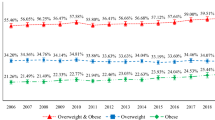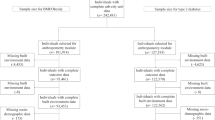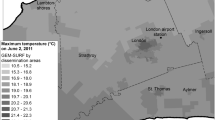Abstract
Background:
The macrogeographic distribution of obesity in the United States, including the association between elevation and body mass index (BMI), is largely unexplained. This study examines the relationship between obesity and elevation, ambient temperature and urbanization.
Methods and Findings:
Data from a cross-sectional, nationally representative sample of 422 603 US adults containing BMI, behavioral (diet, physical activity, smoking) and demographic (age, sex, race/ethnicity, education, employment, income) variables from the 2011 Behavioral Risk Factor Surveillance System were merged with elevation and temperature data from WorldClim and with urbanization data from the US Department of Agriculture. There was an approximately parabolic relationship between mean annual temperature and obesity, with maximum prevalence in counties with average temperatures near 18 °C. Urbanization and obesity prevalence exhibited an inverse relationship (30.9% in rural or nonmetro counties, 29.2% in metro counties with <250 000 people, 28.1% in counties with population from 250 000 to 1 million and 26.2% in counties with >1 million). After controlling for urbanization, temperature category and behavioral and demographic factors, male and female Americans living <500 m above sea level had 5.1 (95% confidence interval (CI) 2.7–9.5) and 3.9 (95% CI 1.6–9.3) times the odds of obesity, respectively, as compared with counterparts living ⩾3000 m above sea level.
Conclusions:
Obesity prevalence in the United States is inversely associated with elevation and urbanization, after adjusting for temperature, diet, physical activity, smoking and demographic factors.
This is a preview of subscription content, access via your institution
Access options
Subscribe to this journal
Receive 12 print issues and online access
$259.00 per year
only $21.58 per issue
Buy this article
- Purchase on Springer Link
- Instant access to full article PDF
Prices may be subject to local taxes which are calculated during checkout



Similar content being viewed by others
References
Flegal KM, Carroll MD, Kit BK, Ogden CL . Prevalence of obesity and trends in the distribution of body mass index among US adults, 1999–2010. JAMA 2012; 307: 491–497.
Ogden CL, Carroll MD, Kit BK, Flegal KM . Prevalence of obesity and trends in body mass index among US children and adolescents, 1999–2010. JAMA 2012; 307: 483–490.
Centers for Disease Control and Prevention. Overweight and obesity, 2012. [cited 2012 June 15]; Available from http://www.cdc.gov/obesity/data/adult.html.
Hamad N, Travis SP . Weight loss at high altitude: pathophysiology and practical implications. Eur J Gastroenterol Hepatol 2006; 18: 5–10.
Shukla V, Singh SN, Vats P, Singh VK, Singh SB, Banerjee PK . Ghrelin and leptin levels of sojourners and acclimatized lowlanders at high altitude. Nutr Neurosci 2005; 8: 161–165.
Lippl FJ, Neubauer S, Schipfer S, Lichter N, Tufman A, Otto B et al. Hypobaric hypoxia causes body weight reduction in obese subjects. Obesity (Silver Spring) 2010; 18: 675–681.
Tschop M, Strasburger CJ, Hartmann G, Biollaz J, Bartsch P . Raised leptin concentrations at high altitude associated with loss of appetite. Lancet 1998; 352: 1119–1120.
Vats P, Singh VK, Singh SN, Singh SB . High altitude induced anorexia: effect of changes in leptin and oxidative stress levels. Nutr Neurosci 2007; 10: 243–249.
Baze MM, Schlauch K, Hayes JP . Gene expression of the liver in response to chronic hypoxia. Physiol Genomics 2010; 41: 275–288.
Yingzhong Y, Droma Y, Rili G, Kubo K . Regulation of body weight by leptin, with special reference to hypoxia-induced regulation. Intern Med 2006; 45: 941–946.
Sierra-Johnson J, Romero-Corral A, Somers VK, Johnson BD . Effect of altitude on leptin levels, does it go up or down? J Appl Physiol 2008; 105: 1684–1685.
Ambrosini G, Nath AK, Sierra-Honigmann MR, Flores-Riveros J . Transcriptional activation of the human leptin gene in response to hypoxia. Involvement of hypoxia-inducible factor 1. J Biol Chem 2002; 277: 34601–34609.
Vats P, Singh SN, Shyam R, Singh VK, Singh SB, Banerjee PK et al. Leptin may not be responsible for high altitude anorexia. High Alt Med Biol 2004; 5: 90–92.
Snyder EM, Carr RD, Deacon CF, Johnson BD . Overnight hypoxic exposure and glucagon-like peptide-1 and leptin levels in humans. Appl Physiol Nutr Metab 2008; 33: 929–935.
Gonzales GF, Tapia V . Birth weight charts for gestational age in 63,620 healthy infants born in Peruvian public hospitals at low and at high altitude. Acta Paediatr 2009; 98: 454–458.
Moore LG, Shriver M, Bemis L, Vargas E . An evolutionary model for identifying genetic adaptation to high altitude. Adv Exp Med Biol 2006; 588: 101–118.
Sorensen HT, Sabroe S, Rothman KJ, Gillman M, Fischer P, Sorensen TI . Relation between weight and length at birth and body mass index in young adulthood: cohort study. BMJ 1997; 315: 1137.
Yip R, Binkin NJ, Trowbridge FL . Altitude and childhood growth. J Pediatr 1988; 113: 486–489.
Dang S, Yan H, Yamamoto S . High altitude and early childhood growth retardation: new evidence from Tibet. Eur J Clin Nutr 2008; 62: 342–348.
Barnholt KE, Hoffman AR, Rock PB, Muza SR, Fulco CS, Braun B et al. Endocrine responses to acute and chronic high-altitude exposure (4300 meters): modulating effects of caloric restriction. Am J Physiol Endocrinol Metab 2006; 290: E1078–E1088.
Sherpa LY, Deji, Stigum H, Chongsuvivatwong V, Thelle DS, Bjertness E . Obesity in Tibetans aged 30-70 living at different altitudes under the north and south faces of Mt. Everest. Int J Environ Res Public Health 2010; 7: 1670–1680.
Tyagi R, Tungdim MG, Bhardwaj S, Kapoor S . Age, altitude and gender differences in body dimensions. Anthropol Anz 2008; 66: 419–434.
Lund EAP, Kirk C, Klausner J . Obesity in adult dogs from private US veterinary practices. Intern J Appl Res Vet Med 2006; 4: 10.
Khalid Mel H . Is high-altitude environment a risk factor for childhood overweight and obesity in Saudi Arabia? Wilderness Environ Med 2008; 19: 157–163.
Baracco R, Mohanna S, Seclen S . A comparison of the prevalence of metabolic syndrome and its components in high and low altitude populations in peru. Metab Syndr Relat Disord 2007; 5: 55–62.
Lutfiyya MN, Chang LF, Lipsky MS . A cross-sectional study of US rural adults’ consumption of fruits and vegetables: do they consume at least five servings daily? BMC public health 2012; 12: 280.
Centers for Disease Control and Prevention (CDC). Behavioral Risk Factor Surveillance System Survey Data. Atlanta, Georgia: US Department of Health and Human Services, Centers for Disease Control and Prevention, 2011.
Parker T . 2004 ERS County Typology Codes. In USDAUSDA, Economic Research Service 2009.
Hijmans R, Cameron S, Parra J, Jones P, Jarvis A . Very high resolution interpolated climate surfaces for global land areas. Int J Climatol 2005; 25: 1965–1978.
Ge RL, Wood H, Yang HH, Liu YN, Wang XJ, Babb T . The body weight loss during acute exposure to high-altitude hypoxia in sea level residents. Sheng Li Xue Bao 2010; 62: 541–546.
Williams PT . Evidence that obesity risk factor potencies are weight dependent, a phenomenon that may explain accelerated weight gain in western societies. PLoS One 2011; 6: e27657.
Goldberg S, Buhbut E, Mimouni FB, Joseph L, Picard E . Effect of moderate elevation above sea level on blood oxygen saturation in healthy young adults. Respiration 2012; 84: 207–211.
Tannheimer M, Thomas A, Gerngross H . Oxygen saturation course and altitude symptomatology during an expedition to broad peak (8047 m). Int J Sports Med 2002; 23: 329–335.
Wagner PD . Operation Everest II. High Alt Med Biol 2010; 11: 111–119.
Aeberli I, Erb A, Spliethoff K, Meier D, Gotze O, Fruhauf H et al. Disturbed eating at high altitude: influence of food preferences, acute mountain sickness and satiation hormones. Eur J Nutr 2012. e-pub ahead of print 11 May 2012.
Netzer NC, Chytra R, Kupper T . Low intense physical exercise in normobaric hypoxia leads to more weight loss in obese people than low intense physical exercise in normobaric sham hypoxia. Sleep Breath 2008; 12: 129–134.
Norese MF, Lezon CE, Alippi RM, Martinez MP, Conti MI, Bozzini CE . Failure of polycythemia-induced increase in arterial oxygen content to suppress the anorexic effect of simulated high altitude in the adult rat. High Alt Med Biol 2002; 3: 49–57.
Quintero P, Milagro FI, Campion J, Martinez JA . Impact of oxygen availability on body weight management. Med Hypotheses 2010; 74: 901–907.
Vaanholt LM, Daan S, Schubert KA, Visser GH . Metabolism and aging: effects of cold exposure on metabolic rate, body composition, and longevity in mice. Physiol Biochem Zool 2009; 82: 314–324.
Zhao ZJ, Chi QS, Cao J, Han YD . The energy budget, thermogenic capacity and behavior in Swiss mice exposed to a consecutive decrease in temperatures. J Exp Biol 2010; 213 (Pt 23): 3988–3997.
Wijers SL, Schrauwen P, Saris WH, van Marken Lichtenbelt WD . Human skeletal muscle mitochondrial uncoupling is associated with cold induced adaptive thermogenesis. PLoS One 2008; 3: e1777.
Hansen JC, Gilman AP, Odland JO . Is thermogenesis a significant causal factor in preventing the "globesity" epidemic? Med Hypotheses 2010; 75: 250–256.
McAllister EJ, Dhurandhar NV, Keith SW, Aronne LJ, Barger J, Baskin M et al. Ten putative contributors to the obesity epidemic. Crit Rev Food Sci Nutr 2009; 49: 868–913.
Young PM, Rose MS, Sutton JR, Green HJ, Cymerman A, Houston CS . Operation Everest II: plasma lipid and hormonal responses during a simulated ascent of Mt. Everest. J Appl Physiol 1989; 66: 1430–1435.
Loshbaugh JE, Loeppky JA, Greene ER . Effects of acute hypobaric hypoxia on resting and postprandial superior mesenteric artery blood flow. High Alt Med Biol 2006; 7: 47–53.
Wilson MJ, Lopez M, Vargas M, Julian C, Tellez W, Rodriguez A et al. Greater uterine artery blood flow during pregnancy in multigenerational (Andean) than shorter-term (European) high-altitude residents. Am J Physiol Regul Integr Comp Physiol 2007; 293: R1313–R1324.
Galan HL, Rigano S, Radaelli T, Cetin I, Bozzo M, Chyu J et al. Reduction of subcutaneous mass, but not lean mass, in normal fetuses in Denver, Colorado. Am J Obstet Gynecol 2001; 185: 839–844.
Hankey S, Marshall JD, Brauer M . Health impacts of the built environment: within-urban variability in physical inactivity, air pollution, and ischemic heart disease mortality. Environ Health Perspect 2012; 120: 247–253.
Ebrahim S, Kinra S, Bowen L, Andersen E, Ben-Shlomo Y, Lyngdoh T et al. The effect of rural-to-urban migration on obesity and diabetes in India: a cross-sectional study. Plos Med 2010; 7: e1000268.
Befort CA, Nazir N, Perri MG . Prevalence of obesity among adults from rural and urban areas of the United States: findings from NHANES (2005-2008). J Rural Health 2012; 28: 392–397.
Ezzati M, Martin H, Skjold S, Vander Hoorn S, Murray CJ . Trends in national and state-level obesity in the USA after correction for self-report bias: analysis of health surveys. J R Soc Med 2006; 99: 250–257.
Acknowledgements
Matthew Gilbert provided help with Microsoft Access. Robert Smalley provided help with Microsoft Excel and suggested quantile regression. Daniel Burnett first presented and discussed BRFSS obesity maps with principal investigator and discussed the referent group. Roger Gibson reviewed the project and discussed with Principal Investigator. Cara Olsen provided biostatistical support and Tzucheg Kao provided base code for GEE in SAS. The USUHS School of Medicine Office of Research approved this study as non-human subjects research. The project was completed while the principal investigator was in training within the USUHS Public Health and General Preventive Medicine Residency.
Author contributions
Study concept and design: J Voss and P Masuoka; acquisition of data: J Voss, P Masuoka and AI Scher; analysis and interpretation of data: J Voss, P Masuoka, BJ Webber, AI Scher and RL Atkinson; drafting of the manuscript: J Voss, P Masuoka and BJ Webber; critical revision of the manuscript for important intellectual content: P Masuoka, AI Scher and RL Atkinson; statistical analysis: J Voss, P Masuoka, BJ Webber, AI Scher and RL Atkinson; administrative, technical or material support: P Masuoka and AI Scher; study supervision: AI Scher and RL Atkinson.
Disclaimer
This work is the sole responsibility of the authors and does not represent the official views of the Uniformed Services University of the Health Sciences, Department of Defense or Virginia Commonwealth University.
Author information
Authors and Affiliations
Corresponding author
Ethics declarations
Competing interests
The authors declare no conflict of interest.
Additional information
Supplementary Information accompanies the paper on International Journal of Obesity website
Supplementary information
Rights and permissions
About this article
Cite this article
Voss, J., Masuoka, P., Webber, B. et al. Association of elevation, urbanization and ambient temperature with obesity prevalence in the United States. Int J Obes 37, 1407–1412 (2013). https://doi.org/10.1038/ijo.2013.5
Received:
Revised:
Accepted:
Published:
Issue Date:
DOI: https://doi.org/10.1038/ijo.2013.5
Keywords
This article is cited by
-
Revisiting the COVID-19 fatality rate and altitude association through a comprehensive analysis
Scientific Reports (2022)
-
The effect of HIF on metabolism and immunity
Nature Reviews Nephrology (2022)
-
Urban Scaling of Health Outcomes: a Scoping Review
Journal of Urban Health (2022)
-
The effect of air pollution and emotional and behavioral problems on preschoolers’ overweight and obesity
Environmental Science and Pollution Research (2022)
-
Food, physical activity, and health deserts in Alabama: the spatial link between healthy eating, exercise, and socioeconomic factors
GeoJournal (2022)



